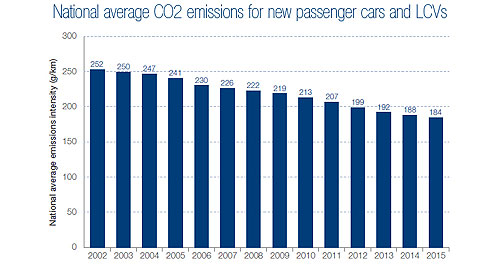News - General News - EmissionsRate of new-car emissions decline stallsFacing facts: If Australians who bought a new car last year chose the one with best-in-class emissions, the national average CO2 rate would be at 82g/km. The actual result was 184g/km. Tailpipe emissions in Australia on downward trend but 4g/km drop no better than 20142 Apr 2016 By TERRY MARTIN THE rate of decline for Australia’s national average carbon dioxide emissions across all new passenger cars and light commercial vehicles stalled last year, with the fall of four grams per kilometre – to 184g/km – no better than the result achieved a year earlier. As was the case in 2014, the 4g/km reduction (rounded up from 3.6g/km) was the slowest annual improvement since 2009 and, notwithstanding the positive downward trend, the nation’s overall result remains in stark contrast to Europe, which introduced legislation seven years ago that capped the CO2 fleet average at 130g/km by 2015 – a mark it achieved two years ahead of schedule. By 2021, phased in from 2020, the European CO2 average will be down to 95g/km, while Australia has no comparable targets or mandatory requirements. The annual CO2 report released by the National Transport Commission (NTC) last weekend, which uses data from the Federal Chamber of Automotive Industries (FCAI), shows that average CO2 emissions for new passenger cars in Australia fell by just 2g/km last year – now at 175g/km – while light commercials accounted for the bulk of the national improvement, down 6g/km to 229g/km. By comparison, the LCV average in the EU was at 169g/km in 2014 – significantly below the legislative requirement of 175g/km by 2017. The stagnant rate of decline in Australia comes despite Australian consumers purchasing a record number of ‘green’ cars last year, with NTC chief executive Paul Retter highlighting that 52,613 new cars sold last year were classified low-emissions vehicles (emitting less than 120g/km), which equates to 4.7 per cent of the total market (sans heavy commercials) – up from 2.8 per cent in 2014. “Today’s consumers are spoilt for choice. In 2015 there were 72 different types of fuel-efficient cars on the market, up from just 59 in 2014,” he said. “Back in 2008 there were just seven fuel-efficient cars available.” However, Mr Retter added that while Australian consumers were increasingly choosing lower-emissions cars, “the overwhelming majority still preferred other types of vehicles”. “If all Australians who bought a new vehicle in 2015 bought one with best-in-class emissions, the national average carbon emissions intensity would have dropped by 55 per cent (to 82g/km) compared to 2014,” he said. As it has done in previous years, the NTC lists a number of obvious reasons why Australia is so far behind Europe, including consumer preference for heavier vehicles with bigger and more powerful engines, the lower fuel prices here and the lack of incentives to purchase low-emissions vehicles. Official VFACTS sales figures routinely illustrate these trends across various market segments, such as the ongoing growth of SUVs at the expense of passenger cars. SUV sales were up 16 per cent last year, accounting for 35 per cent of the total market, while passenger cars were down three per cent (at 45 per cent of the market) and are expected to be overtaken in the next few years. The NTC report shows that the average CO2 emissions for all Australian-made vehicles was 208g/km last year – down just 2g/km – with Ford (-2.5 per cent) and Toyota (-0.6 per cent) offsetting a 1.5 per cent increase in emissions from Holden’s locally manufactured vehicles. Ford’s Australian-built cars, which reach the end of the line in October, still produced the most emissions of the three local car-makers in 2015 – 233g/km collectively, compared to Holden on 220g/km and Toyota, which is the only one of the trio to produce a petrol-electric hybrid car (Camry) and to sit below the national average, was on 176g/km for its local Camry/Aurion range. Government buyers purchased vehicles with the highest average emissions (204g/km) last year, which is unsurprising given the heavy skew towards locally produced cars and imported one-tonne utilities, while business buyers were next on 190g/km and private buyers well out in front in terms of green vehicle purchases, on 178g/km. A national reform process to reduce noxious and CO2 emissions from the road transport sector is currently underway via a ministerial forum, but nothing will be decided for more than a year – well after the forthcoming federal election. An interdepartmental working group led by the department of infrastructure and regional development will deliver a draft implementation plan for new measures to reduce road transport emissions by March 31, 2017. A wide-ranging discussion paper was released in February this year – and was cautiously welcomed by industry groups such as the FCAI and the Australian Automobile Association (AAA) – and submissions on the issue have been received since then, closing April 8. A draft report will be delivered by June 30 this year, followed by consultation on the draft regulation impact statements. In response to the NTC report’s release, FCAI chief executive Tony Weber said: “The Australian automotive industry remains committed to a mandated CO2 target that is relevant to Australia. Any CO2 target must be considered together with pollutant emission standards and fuel quality standards as they are all interrelated.”  Read more2nd of April 2016  Market Insight: Mixed CO2 results for top brandsNissan improves most, but still at back of field, in latest NTC CO2 report card12th of February 2016  Cautious welcome for emissions discussion paperThorough consultation needed for smooth vehicle emissions transition: AAA, FCAI24th of April 2015  Market Insight: The great green car dilemmaGulf between greenest cars, top sellers widens with new tech vs traditional values20th of April 2015  Market Insight: New-car emissions down but rate slowsTailpipe emissions in Australia fall, but 2.3 per cent drop the slowest since 2009 |
Click to shareGeneral News articlesResearch General News Motor industry news |
















Facebook Twitter Instagram